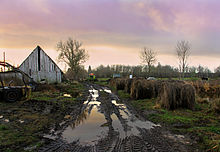
Like the rest of the economy, agriculture in Estonia has been in great flux since the degeneration of the collective and state farm systems.[1]
History[edit]

In 1991 roughly 12 percent of the labor force was employed in agriculture, producing 15.4 percent of Estonia's GDP.[1] Estonia has 985,000 hectares of utilised agricultural land, 707,000 hectares of which are arable.[2] During the Soviet era, arable land decreased by nearly 405,000 hectares, much becoming forest.[1] Collectivization in the late 1940s and 1950s brought great hardship to Estonian agriculture, which during the first independence period had been the mainstay of Estonian society.[1] Still, Estonian agriculture remained more productive than the Soviet average.[1] In 1990 there were 221 collective and 117 state farms with an average of 350 to 400 workers each.[1] The average livestock herd per farm included 1,900 cattle and 2,500 pigs.[1] Estonia was a net exporter of meat and milk to the other republics.[1] Agriculture also served as the basis for the republic's strong food-processing industry.[1] For its meat production, however, Estonia relied heavily on feed grain from Russia.[1] When the republic sought to cut back on meat exports in the late 1980s, Russia retaliated by slowing the provision of feed grain, which cut Estonian production even further.[1] Increases in fuel prices and a general fuel crisis in early 1992 also hit agricultural production very hard.[1] Although the total area of field crops grew in the early 1990s, total production and average yields fell markedly.[1]
Reform of Estonia's agricultural system began in December 1989 with adoption of the Law on Private Farming (Estonian: Eesti NSV taluseadus).[1] The law allowed individuals to take up to fifty hectares of land for private planting and for growing crops.[1] The land was heritable but could not be bought or sold.[1] The goal of the reform was to stimulate production and return the spirit of private farming to a countryside worn down by decades of central planning.[1] Six months after implementation, nearly 2,000 farms were set up, with several thousand waiting for approval.[1] A year later, more than 3,500 private farms were operating.[1] Starting in October 1991, farmers were allowed to own their land.[1] This boosted the number of farms to 7,200 by early 1992.[1] As of the first half of 1993, a total of 8,781 farms had been created, covering approximately 225,000 hectares, or a quarter of Estonia's arable land.[1]
In May 1993, the Estonian parliament passed a law on property taxes, which had been a major concern for many farmers before getting into business.[1] The law mandated a 0.5 percent tax on property values to be paid to the state and a 0.3 to 0.7 percent share to be paid to local governments.[1] More than property taxes, the costs of commodities such as fuel and new equipment were considered most likely to prove burdensome to many new farmers.[1]
With the introduction of private agriculture, many collective farms began to disintegrate.[1] Corruption and "spontaneous privatization" of farm equipment by farm directors grew.[1] A number of Estonia's more successful farms were reorganized into cooperatives.[1] Over the long term, the government predicted that 40,000 to 60,000 private farms averaging fifty hectares would be optimal.[1] At the same time, Estonians were likely to maintain a very high rate of consumption of home-grown fruits and vegetables.[1] A 1993 survey by the Estonian State Statistics Board indicated that nearly 80 percent of all potatoes consumed by Estonians either were privately grown or were received from friends or relatives.[1] Thirty percent of eggs were received outside the market as well as 71.5 percent of all juice.[1] Overall, Estonians reported getting over 20 percent of their food from private production or from friends or relatives.[1]
Production[edit]
Estonia produced in 2018:
- 450 thousand tons of wheat;
- 347 thousand tons of barley;
- 113 thousand tons of rapeseed;
- 88 thousand tons of potato;
- 78 thousand tons of oat;
- 53 thousand tons of pea;
- 29 thousand tons of rye;
In addition to smaller productions of other agricultural products. [3]
Forestry[edit]
Estonia has 1.8 million hectares of forest with approximately 274 million cubic meters of timber.[1] Accounting for about 9 percent of industrial production in 1992, forest-related industries seem likely to grow further in the 1990s, thanks to expanding furniture and timber exports.[1]
Fishing[edit]

The fishing industry, once entirely under Soviet control, also has the potential to contribute to the country's economy.[1] With 230 ships, including ninety oceangoing vessels, this profitable industry operated widely in international waters.[1] A large share of Estonia's food-industry exports consists of fish and fish products.[1] In 1992 about 131,000 tons of live fish were caught.[1]
References[edit]
- ^ a b c d e f g h i j k l m n o p q r s t u v w x y z aa ab ac ad ae af ag ah ai aj ak al am Pettai, Velio A. (1996). "Estonia: Agriculture". In Iwaskiw, Walter R. (ed.). Estonia, Latvia & Lithuania: country studies (1st ed.). Washington, D.C.: Federal Research Division, Library of Congress. pp. 56–60. ISBN 0-8444-0851-4. OCLC 34245562.
 This article incorporates text from this source, which is in the public domain.
This article incorporates text from this source, which is in the public domain.{{cite encyclopedia}}: CS1 maint: postscript (link) - ^ "Agriculture | Statistikaamet". www.stat.ee. Retrieved 2023-07-12.
- ^ Estonia production in 2018, by FAO